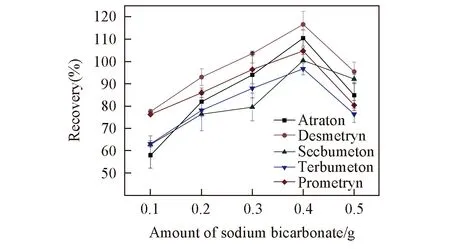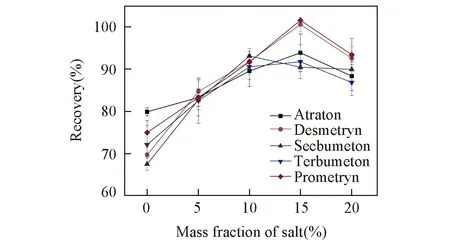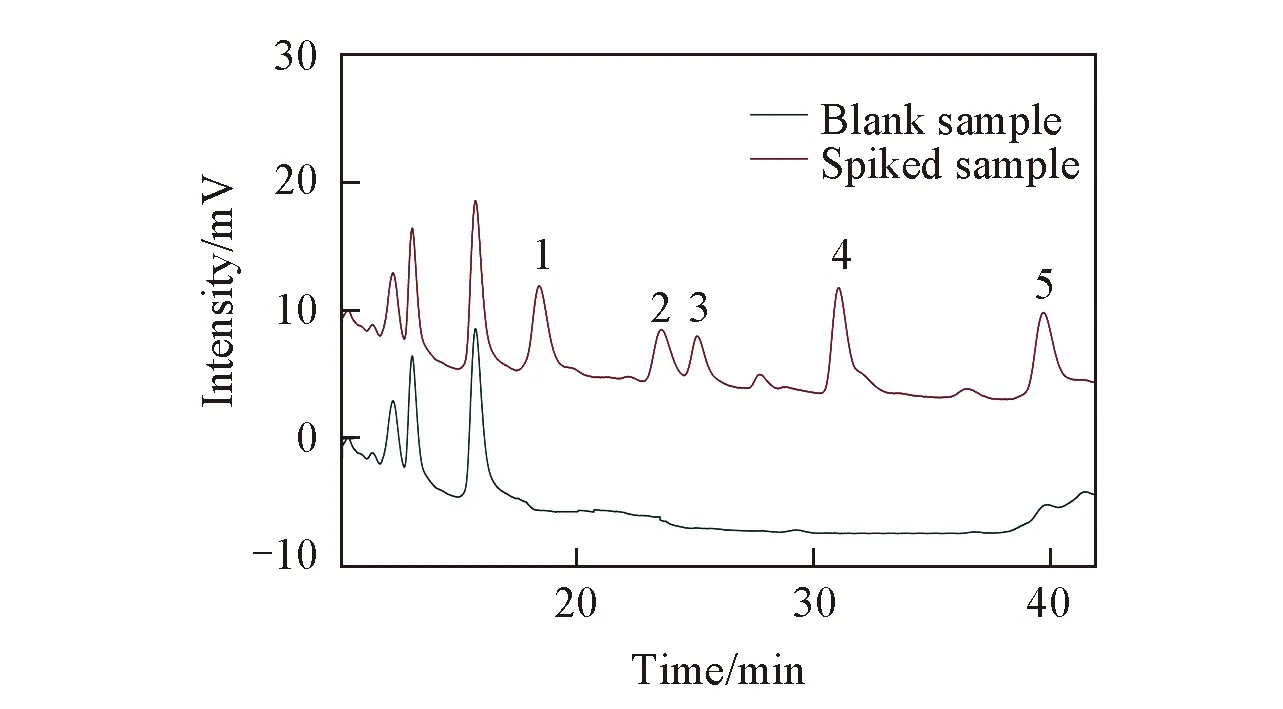Determination of Triazine Herbicides from Fruit Juice Samples Using Effervescence Assisted Microextraction Method Based on Acidic Ionic Liquid Packed Syringe
PIAO Huilan, MA Pinyi, QIN Zucheng, JIANG Yanxiao, SUN Ying,WANG Xinghua, SONG Daqian
(College of Chemistry, Jilin University, Changchun 130012, China)
Abstract A rapid, efficient, eco-friendly and simple effervescence assisted microextraction method based on acidic ionic liquid packed syringe was proposed for the determination of triazine herbicides in fruit juice samples. The extraction and dispersion procedure was achieved using an acidic ionic liquid [C4mim][HSO4]. It possesses high solubility for triazine herbicides and acidity that can generate carbon dioxide, which accelerates the extraction procedure via reacting with carbonate. The dispersion and separation were carried out in a syringe. Thus, the whole pretreatment procedure was completely free of any equipment. A variety of experimental conditions affecting extraction efficiency, including amount of sodium bicarbonate, amount of acidic ionic liquid, salt addition and volume of elution solvent were optimized. Under the optimal conditions, good linearities were obtained in the range of 1—200 ng/mL, with coefficients better than 0.9984. The limit of detection(LOD) and limit of quantification(LOQ) varied from 0.06 to 0.18 ng/mL and 0.21 to 0.61 ng/mL, respectively. The intra-day and inter-day precisions were lower than 8.3%. The developed technique was successfully applied for determination of triazine herbicides in fruit juice samples.
Keywords Acidic ionic liquid; Effervescence assisted microextraction; Triazine herbicide
Triazines are extensively consumed and used for weed control to increase crop yield throughout the world[1]. However, owing to the property of the triazines that they can be permanently accumulated in human body, this accumulation can generate a series of problems to human health including birth defects, cancers, and may interfere with the endocrine system[2,3]. As a result, developing a simple, sensitive and rapid sample pretreatment method is generally sought after.
A variety of methods have been proposed to analyze target analytes from aqueous samples. Conventional methods, such as liquid-liquid extraction(LLE) and liquid-solid extraction(LSE), have been extensively employed to sample pretreatments[4,5]. However, these methods are time consuming and require a large consumption of organic solvents which restrict their further application. Taking into account these drawbacks, a series of sample pretreatment techniques have been emerged including solid-phase microextraction(SPME)[6,7], liquid-liquid microextraction(LLME)[8,9], matrix solid dispersion(MSPD)[10,11], and stir bar sorptive extraction(SBSE)[12,13].
Effervescence assisted liquid-liquid dispersion method, introduced by Lasarte-Aragoneetal., has been considered as a green and effective means for the analyzing aqueous sample[14]. In contrast to recently exploited dispersing techniques, such as ultrasonication, mechanical agitation, microwave, and nitrogen foam flotation, analytes are extracted by a simple chemical reaction without any energy source for dispersion. In this procedure, carbon dioxide formed by carbonate and acid causes the extraction solvent or sorbent to disperse in the aqueous media[15,16]. It increases the contact area between the extraction agent and analytes which further leads to acceleration in the velocity of the extraction procedure, enhancing extraction efficiency.
As we know, ionic liquids are considered to be one of the most valuable solvents in the analytical community since it is able to facilitate negligible vapor pressure, wide ranges of viscosity, high chemical and thermal stabilities, and possesses low toxicity[17]. In particular, another property of ionic liquids is their versatility which is achieved by changing or functionalizing the cation and anion, making it a desirable material[18,19]. Due to the beneficial properties of ionic liquids, they are widely applied in a variety of analytical chemistry techniques[20―22].
In the present study, we proposed an effective and eco-friendly technique using an acidic ionic liquid based upon effervescence assisted microextraction method. The acidic ionic liquid [C4mim][HSO4] was used as an extraction solvent and dispersant. During extraction, the ionic liquid was dispersed by carbon dioxide that is generated by the reaction of the anion of the ionic liquid with bicarbonate in the solution. Meanwhile, the hydrophobic ionic liquid [C4mim][PF6] who can be easily separated from the aqueous solution was formed by reacting with the ion-exchange material NH4PF6. Moreover, the method does not require any equipment during the whole pretreatment procedure. The main variables evaluated in this method are the amount of bicarbonate and acidic ionic liquid, salt addition and volume of elution solvent. Under the optimal conditions, the liner range, limit of detection, quantification, precision and accuracy were calculated to estimate the reliability of the method.
1 Experimental
1.1 Reagents
Standard triazine herbicides, including atraton, desmetryn, secbumeton, terbumeton and prometryn were purchased from National Institute for the Control of Pharmaceutical and Biological Products(Beijing, China). Standard individual stock solutions(500 mg/mL) and mixed working solution(5 mg/mL) of triazines were prepared using chromatographical acetonitrile purchased from Fisher Scientific Company(UK) and kept at 4 ℃ in darkness.
Acidic ionic liquid [C4mim][HSO4](>99%, its chemical structure was shown in Fig.1) and ion-exchange reagent NH4PF6(>99%) were obtained from Chengjie Chemical Co. Ltd.(Shanghai, China). Sodium chloride, sodium bicarbonate and diethyl ether were of analytical grade and were purchased from Beijing Chemical Factory(Beijing, China). Ultrapure water was prepared on a Milli-Q water purification system(Millipore Company, USA).

Fig.1 Chemical structure of [C4mim][HSO4]
1.2 Instrument
LC-20ADXR liquid chromatograph(Shimadzu Company, Japan) was carried for analysis. It consisted of two LC-20AD pumps, an SIL-20A automated sample injector, a CTO-20A column oven and an SPD-20A UV-Vis detector. An eclipse XDB-C18 column(150 mm×4.6 mm, with 3.5 mm particle size; Agilent Technologies Inc., USA) was employed for separation of analytes.
1.3 HPLC Analysis
The HPLC analysis was conducted in gradient mode and previously optimized. Mobile phase consists of acetonitrile(A) and water(B). The gradient condition was as follows: 0—5 min, 80%—75%B; 5—10 min, 75%—70%B; 10—25 min,70%—65%B; 25—35 min, 65%—60%B; 35—50 min, 60%—55%B. The flow rate of mobile phase was 0.8 mL/min, and the detection wavelength for all target analytes was 220 nm. The sample injection volume was 20 mL.
1.4 Sample Preparation
Fruit juice(sample 1), tea beverage(sample 2), and drinking water(sample 3) samples were prepared from local supermarkets. Before extraction, all the aqueous samples were filtered through 0.22 mm nylon filter and stored in a refrigerator at 4 ℃. Except for the experiments performed in Section 2.3, all experiments were carried out using sample 1.
1.5 In-syringe Effervescence Assisted Microextraction Procedure
10 mL of fruit juice sample containing 1.5 g NaCl, 0.4 g NaHCO3and 0.37 g NH4PF6was loaded in a 20 mL-syringe. 500 mg of acidic ionic liquid [C4mim][HSO4] was injected into the sample solution from the bottom of the 20 mL syringe through the tip of a 1.0 mL syringe. At that moment, large amounts of carbon dioxide were produced. Under continuous bubbling, the analytes were extracted from the ionic liquid. Simultaneously, the hydrophobic ionic liquid was formed due to the reaction of hydrophilic ionic liquid with the ionexchange reagent NH4PH6. Once the chemical reaction ceased, the aqueous solution was slowly expelled through a 0.22 mm nylon syringe membrane. Meanwhile, the hydrophobic ionic liquid was left in the syringe. During the procedure, the syringe was laid in parallel to the bench to avoid loss of ionic liquid. Subsequently, 3 mL of diethyl ether was added to the syringe and shaken to dissolve the target analytes from the ionic liquid. After that, the diethyl ether phase was separated and evaporated under N2flow. 100 mL of acetonitrile was added to re-dissolve the dried residue and 20 mL of solution was injected into the HPLC system for analysis. The procedure of the pretreatment has been displayed graphically(Scheme 1).

Scheme 1 Schematic of the extraction procedureDLLME: dispersive liquid-liquid microextraction.
2 Results and Discussion
2.1 Optimization of Sampling Conditions
To obtain the greatest extraction efficiency, different extraction conditions, such as amount of acidic ionic liquid and NaHCO3, salt addition, and volume of elution solvent were evaluated. Spiked concentration level in the sample solution was 10 ng/mL and all optimization experiments were performed in triplicate.
2.1.1OptimizationoftheAmountofAcidicIonicLiquidThe amount of acidic ionic liquid [C4mim][HSO4] used as both a dispersant and extraction solvent shows significant influence on extraction efficiency. Thus, selecting an optimized amount is of utmost importance. Increasing the amount of acidic ionic liquid produced a continuous increase of the extraction recovery in the range of 200—600 mg. We found that the recovery no longer improved when greater than 500 mg of acidic ionic liquid was added(Fig.2). Thus, 500 mg of acidic ionic liquid was used in subsequent experiments.

Fig.2 Effect of amount of acidic ionic liquid on recoveryAmount of NaHCO3: 0.4 g; mass fraction of salt: 15%; volume of elution solvent: 3 mL.

Fig.3 Effect of amount of NaHCO3 on recoveryAmount of acidic ionic liquid: 500 mg; mass fraction of salt: 15%; volume of elution solvent: 3 mL.
2.1.2OptimizationoftheAmountofSodiumBicarbonateTo achieve a satisfactory production of carbon dioxide, the amount of sodium bicarbonate added is crucial to the extraction process. However, too much NaHCO3could decrease the extraction efficiency due to the high ionic strength of the sample solution[23]. We observed that the best recovery for the majority of analytes was when the amount of NaHCO3was 0.4 g(Fig.3). Therefore, 0.4 g of NaHCO3was used in subsequent experiments.
2.1.3OptimizationofSaltAdditionSalt addition to the pretreatment procedure could enhance the extraction efficiency due to the salting-out effect, which decrease the solubility of organic analytes in water, and is regarded as one of the most important factors in this method[24]. Nevertheless, considering the high ionic strength of the solution, which can decrease the solubility of the analytes in the sample solution, excess addition of salt may result in opposite effect[23]. When the mass fraction of salt was increased in the solution, the recovery of the target analytes was increased when salt addition ranged from 0 to 15%, while the recovery was decreased when the mass fraction of salt was higher than 15%(Fig.4). Thus, 15% of salt addition was chosen for subsequent experiments.

Fig.4 Effect of mass fraction of salt on recoveryAmount of acidic ionic liquid: 500 mg; amount of NaHCO3: 0.4 g; volume of elution solvent: 3 mL.

Fig.5 Effect of volume elution solvent on recoveryAmount of acidic ionic liquid: 500 mg; amount of NaHCO3: 0.4 g; mass fraction of salt: 15%.
2.1.4OptimizationofVolumeofElutionSolventA proper elution solvent is important forimproving the extraction efficiency. Diethyl ether has high solubility for target analytes and displays a low solubility for the ionic liquid, therefore, diethyl ether was chosen as elution solvent. In addition, different volumes of diethyl ether were tested. The curvilinear trend of recovery was increased from 1.5 to 3.0 mL, while no significant enhancements were observed when the elution volume is more than 3 mL(Fig.5). Thus, 3 mL of the elution solvent was chosen for the subsequent experiments.
2.2 Validation of Method
Under the optimal conditions, the proposed method was validated on the basis of linearity, sensitivity, accuracy and precision.
The calibration curves were constructed by plotting the mean peak areavs. seven concentration levels of sample solutions. This method exhibited good linearity(1—200 ng/mL) with satisfactory coefficientR2within 0.9984. The limit of detections(LODs) and limit of quantifications(LOQs)(signal-to-noise ratio of 3 and 10, respectively) were used to evaluate the sensitivity and were in the range of 0.06—0.18 ng/mL and 0.21—0.61 ng/mL, respectively(see Table 1).
Furthermore, the intra-day and inter-day RSDs(Relative standard deviations)(n=5), used to measure precision of the method, were lower than 6.8% and 7.8%, respectively(see Table 1).

Table 1 Analytical performances of the present method
2.3 Analysis of Real Sample
The proposed method was used to analyze three types of aqueous samples(fruit juice, tea beverage and drinking water) at three fortified concentration levels to verify the applicability of the method. Measurements were performed under the optimal conditions and all the experiments were conducted in triplicate. Satisfactory recoveries(80.8%—123.5%) and RSDs(within 8.3%), which were used to verify accuracy and precision, respectively, were obtained(see Table 2).

Table 2 Analytical results of real fruit juice samples

Fig.6 HPLC chromatograms of blank and spiked fruit juice samplesPeak 1: atraton; peak 2: desmetryn; peak 3: secbumeton; peak 4: terbumeton; peak 5: prometryn.
In addition, the analysis results of HPLC chromatograms of the blank and spiked samples showed no presence of triazines in the real samples(Fig.6).
2.4 Comparison with Previously Reported Methods
Other published methodologies were compared to the present method[25—30]. The proposed method showed comparable or lower LODs to other methodologies(see Table 3). In addition, there was no need to prepare equipment in the whole pretreatment procedure, which is a favorable analytical feature compared to the previously reported methods.

Table 3 Comparison of the present method with other reported methods
3 Conclusions
In the present study, a rapid, efficient, eco-friendly and simple technique for the determination of triazines herbicides in fruit juice was proposed. The whole pretreatment procedure was easily performed, due to dispersion being driven by chemical reaction in solution, separation and collection of the extractant being easily accomplished in the syringe. For these reason, dispersing and separating equipment were not required to perform this method. Furthermore, acceptable analysis results, including linearity, sensitivity, precision and accuracy, were obtained. In conclusion, the pretreatment technique is robust and reliable for analyzing triazine herbicides in aqueous sample.
This paper is supported by the National Natural Science Foundation of China(No.21405057), the Science and Technology Developing Foundation of Jilin Province of China(No.20180201050YY) and the Industrial Innovation Funds of Jilin Province of China(No.2018C034-1).

